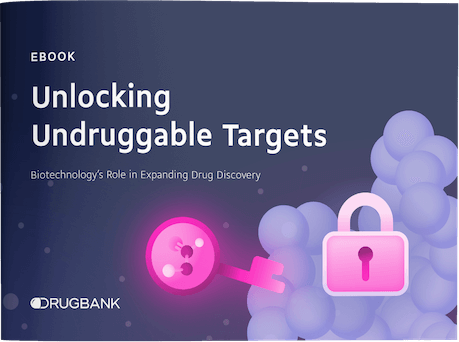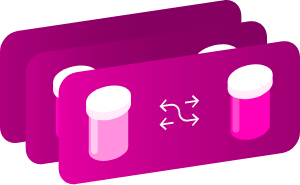Explore a selection of our essential drug information below, or:
Identification
- Summary
Oxytetracycline is a tetracycline antibiotic used to treat a wide variety of susceptible bacterial infections.
- Brand Names
- Terramycin, Urobiotic
- Generic Name
- Oxytetracycline
- DrugBank Accession Number
- DB00595
- Background
A tetracycline analog isolated from the actinomycete streptomyces rimosus and used in a wide variety of clinical conditions.
- Type
- Small Molecule
- Groups
- Approved, Investigational, Vet approved
- Structure
- Weight
- Average: 460.434
Monoisotopic: 460.148180376 - Chemical Formula
- C22H24N2O9
- Synonyms
- 5-Hydroxytetracycline
- Embryostat
- Hydroxytetracyclinum
- Mepatar
- Ossitetraciclina
- Oxitetraciclina
- Oxyterracin
- Oxyterracine
- Oxytetracyclin
- Oxytétracycline
- Oxytetracycline
- Oxytetracycline (anhydrous)
- Oxytetracycline amphoteric
- Oxytetracyclinum
Pharmacology
- Indication
Oxytetracycline is indicated for treatment of infections caused by a variety of Gram positive and Gram negative microorganisms including Mycoplasma pneumoniae, Pasteurella pestis, Escherichia coli, Haemophilus influenzae (respiratory infections), and Diplococcus pneumoniae.
 Reduce drug development failure ratesBuild, train, & validate machine-learning modelswith evidence-based and structured datasets.Build, train, & validate predictive machine-learning models with structured datasets.
Reduce drug development failure ratesBuild, train, & validate machine-learning modelswith evidence-based and structured datasets.Build, train, & validate predictive machine-learning models with structured datasets.- Associated Conditions
Indication Type Indication Combined Product Details Approval Level Age Group Patient Characteristics Dose Form Used in combination to treat Localized infection Combination Product in combination with: Polymyxin B (DB00781) •••••••••••• •••••••• Used in combination for prophylaxis of Skin infections Combination Product in combination with: Polymyxin B (DB00781) •••••••••••• •••••••• Used in combination for prophylaxis of Skin infections Combination Product in combination with: Polymyxin B (DB00781) •••••••••••• •••••••• Used in combination to treat Superficial ocular infections Combination Product in combination with: Polymyxin B (DB00781) •••••••••••• •••••••• Treatment of Susceptible bacteria •••••••••••• - Contraindications & Blackbox Warnings
 Prevent Adverse Drug Events TodayTap into our Clinical API for life-saving information on contraindications & blackbox warnings, population restrictions, harmful risks, & more.Avoid life-threatening adverse drug events with our Clinical API
Prevent Adverse Drug Events TodayTap into our Clinical API for life-saving information on contraindications & blackbox warnings, population restrictions, harmful risks, & more.Avoid life-threatening adverse drug events with our Clinical API- Pharmacodynamics
Oxytetracycline is known as a broad-spectrum antibiotic due to its activity against such a wide range of infections. It was the second of the tetracyclines to be discovered. Oxytetracycline, like other tetracyclines, is used to treat many infections common and rare. Its better absorption profile makes it preferable to tetracycline for moderately severe acne, but alternatives sould be sought if no improvement occurs by 3 months.
- Mechanism of action
Oxytetracycline inhibits cell growth by inhibiting translation. It binds to the 30S ribosomal subunit and prevents the amino-acyl tRNA from binding to the A site of the ribosome. The binding is reversible in nature. Oxytetracycline is lipophilic and can easily pass through the cell membrane or passively diffuses through porin channels in the bacterial membrane.
Target Actions Organism A30S ribosomal protein S9 inhibitorEscherichia coli (strain K12) A30S ribosomal protein S4 inhibitorEscherichia coli (strain K12) U16S ribosomal RNA inhibitorEnteric bacteria and other eubacteria - Absorption
Readily absorbed following oral administration.
- Volume of distribution
Not Available
- Protein binding
Not Available
- Metabolism
- Not Available
- Route of elimination
Not Available
- Half-life
Not Available
- Clearance
Not Available
- Adverse Effects
 Improve decision support & research outcomesWith structured adverse effects data, including: blackbox warnings, adverse reactions, warning & precautions, & incidence rates. View sample adverse effects data in our new Data Library!Improve decision support & research outcomes with our structured adverse effects data.
Improve decision support & research outcomesWith structured adverse effects data, including: blackbox warnings, adverse reactions, warning & precautions, & incidence rates. View sample adverse effects data in our new Data Library!Improve decision support & research outcomes with our structured adverse effects data.- Toxicity
Adverse effects may include stomach or bowel upsets and rarely allergic reactions. Very rarely severe headache and vision problems may be signs of dangerous intracranial hypertenion.
- Pathways
Pathway Category Oxytetracycline Action Pathway Drug action - Pharmacogenomic Effects/ADRs
- Not Available
Interactions
- Drug Interactions
- This information should not be interpreted without the help of a healthcare provider. If you believe you are experiencing an interaction, contact a healthcare provider immediately. The absence of an interaction does not necessarily mean no interactions exist.
Drug Interaction Integrate drug-drug
interactions in your softwareAcamprosate The excretion of Acamprosate can be decreased when combined with Oxytetracycline. Acenocoumarol Oxytetracycline may increase the anticoagulant activities of Acenocoumarol. Acetylcysteine The therapeutic efficacy of Acetylcysteine can be decreased when used in combination with Oxytetracycline. Acetylsalicylic acid The excretion of Oxytetracycline can be decreased when combined with Acetylsalicylic acid. Acitretin The risk or severity of pseudotumor cerebri can be increased when Acitretin is combined with Oxytetracycline. - Food Interactions
- Avoid milk and dairy products. Take at least 1 hour before or two hours after consuming dairy products.
- Take separate from meals. Take at least one hour before or two hours after a meal.
Products
 Drug product information from 10+ global regionsOur datasets provide approved product information including:dosage, form, labeller, route of administration, and marketing period.Access drug product information from over 10 global regions.
Drug product information from 10+ global regionsOur datasets provide approved product information including:dosage, form, labeller, route of administration, and marketing period.Access drug product information from over 10 global regions.- Product Ingredients
Ingredient UNII CAS InChI Key Oxytetracycline calcium C8MRZ07FDV 13303-91-8 KIPLYOUQVMMOHB-MXWBXKMOSA-L Oxytetracycline dihydrate X20I9EN955 6153-64-6 SRRPEXWCHWWJOC-JEKSYDDFSA-N Oxytetracycline hydrochloride 4U7K4N52ZM 2058-46-0 UBDNTYUBJLXUNN-IFLJXUKPSA-N Oxytetracycline monocalcium M90SJ24J2X 7179-50-2 QJHKFWPAQRFQBG-IFLJXUKPSA-L - International/Other Brands
- Adamycin (Teva) / Anglocycline (Anglopak) / Corsamycin (Corsa Industries) / Oxacin (Doctor's Chemical Works) / Oxypan (Adcock Ingram Pharmaceuticals) / Oxyterracyna (Chema) / Terrados (Pfizer) / Tetran (Wagner Pharmafax) / Tetrasona (Medifarma)
- Brand Name Prescription Products
Name Dosage Strength Route Labeller Marketing Start Marketing End Region Image Terramycin Capsule 250 mg/1 Oral Pfizer Labs 2005-12-07 Not applicable US - Mixture Products
Name Ingredients Dosage Route Labeller Marketing Start Marketing End Region Image GEOTRIL POMAD Oxytetracycline hydrochloride (30 mg/g) + Polymyxin B sulfate (1.25 mg/g) Ointment Topical İ.E. ULAGAY İLAÇ SAN. TÜRK A.Ş. 2020-08-14 2021-03-18 Turkey HEKSA 30 MG/G + 10000 I.U./G MERHEM Oxytetracycline (30 mg/g) + Polymyxin B (10000 IU/g) Ointment Topical POLİFARMA İLAÇ SAN. VE TİC. A.Ş. 1986-07-09 Not applicable Turkey HEKSA DERI MERHEMI Oxytetracycline (30 mg/g) + Polymyxin B (10000 IU/g) Ointment Topical POLİFARMA İLAÇ SAN. VE TİC. A.Ş. 1986-07-09 2024-01-23 Turkey OXYLIM Oxytetracycline dihydrate (100 MG/2ML) + Lidocaine (40 MG/2ML) Solution บริษัท โรงงานเภสัชกรรมแอตแลนติค จำกัด 1985-04-24 2020-09-29 Thailand POLIMISIN DERI MERHEMI, 14.2 G Oxytetracycline hydrochloride (30 mg/g) + Polymyxin B sulfate (10000 U) Ointment Topical KOÇAK FARMA İLAÇ VE KİMYA SAN. A.Ş. 2009-07-30 Not applicable Turkey
Categories
- ATC Codes
- J01AA06 — Oxytetracycline
- J01AA — Tetracyclines
- J01A — TETRACYCLINES
- J01 — ANTIBACTERIALS FOR SYSTEMIC USE
- J — ANTIINFECTIVES FOR SYSTEMIC USE
- G01AA — Antibiotics
- G01A — ANTIINFECTIVES AND ANTISEPTICS, EXCL. COMBINATIONS WITH CORTICOSTEROIDS
- G01 — GYNECOLOGICAL ANTIINFECTIVES AND ANTISEPTICS
- G — GENITO URINARY SYSTEM AND SEX HORMONES
- A01AB — Antiinfectives and antiseptics for local oral treatment
- A01A — STOMATOLOGICAL PREPARATIONS
- A01 — STOMATOLOGICAL PREPARATIONS
- A — ALIMENTARY TRACT AND METABOLISM
- J01AA — Tetracyclines
- J01A — TETRACYCLINES
- J01 — ANTIBACTERIALS FOR SYSTEMIC USE
- J — ANTIINFECTIVES FOR SYSTEMIC USE
- D06AA — Tetracycline and derivatives
- D06A — ANTIBIOTICS FOR TOPICAL USE
- D06 — ANTIBIOTICS AND CHEMOTHERAPEUTICS FOR DERMATOLOGICAL USE
- D — DERMATOLOGICALS
- Drug Categories
- Agents that produce neuromuscular block (indirect)
- Alimentary Tract and Metabolism
- Anti-Bacterial Agents
- Anti-Infective Agents
- Antibacterials for Systemic Use
- Antibiotics for Topical Use
- Antiinfectives and Antiseptics for Local Oral Treatment
- Antiinfectives for Systemic Use
- Dermatologicals
- Genito Urinary System and Sex Hormones
- Gynecological Antiinfectives and Antiseptics
- Naphthacenes
- OAT1/SLC22A6 inhibitors
- OAT3/SLC22A8 Inhibitors
- OAT3/SLC22A8 Substrates
- Ophthalmologicals
- Sensory Organs
- Stomatological Preparations
- Tetracyclines
- Chemical TaxonomyProvided by Classyfire
- Description
- This compound belongs to the class of organic compounds known as tetracyclines. These are polyketides having an octahydrotetracene-2-carboxamide skeleton, substituted with many hydroxy and other groups.
- Kingdom
- Organic compounds
- Super Class
- Phenylpropanoids and polyketides
- Class
- Tetracyclines
- Sub Class
- Not Available
- Direct Parent
- Tetracyclines
- Alternative Parents
- Naphthacenes / Anthracenecarboxylic acids and derivatives / Tetralins / Aryl ketones / 1-hydroxy-2-unsubstituted benzenoids / 1-hydroxy-4-unsubstituted benzenoids / Aralkylamines / Cyclohexenones / Tertiary alcohols / Vinylogous acids show 9 more
- Substituents
- 1-hydroxy-2-unsubstituted benzenoid / 1-hydroxy-4-unsubstituted benzenoid / Alcohol / Amine / Amino acid or derivatives / Anthracene carboxylic acid or derivatives / Aralkylamine / Aromatic homopolycyclic compound / Aryl ketone / Benzenoid show 24 more
- Molecular Framework
- Aromatic homopolycyclic compounds
- External Descriptors
- tetracyclines (CHEBI:27701) / Linear tetracyclines, Antibiotic fungicides (C06624) / Linear tetracyclines (LMPK07000005)
- Affected organisms
- Enteric bacteria and other eubacteria
Chemical Identifiers
- UNII
- SLF0D9077S
- CAS number
- 79-57-2
- InChI Key
- IWVCMVBTMGNXQD-PXOLEDIWSA-N
- InChI
- InChI=1S/C22H24N2O9/c1-21(32)7-5-4-6-8(25)9(7)15(26)10-12(21)17(28)13-14(24(2)3)16(27)11(20(23)31)19(30)22(13,33)18(10)29/h4-6,12-14,17,25,27-29,32-33H,1-3H3,(H2,23,31)/t12-,13-,14+,17+,21-,22+/m1/s1
- IUPAC Name
- (4S,4aR,5S,5aR,6S,12aS)-4-(dimethylamino)-3,5,6,10,12,12a-hexahydroxy-6-methyl-1,11-dioxo-1,4,4a,5,5a,6,11,12a-octahydrotetracene-2-carboxamide
- SMILES
- [H][C@@]12[C@@H](O)[C@@]3([H])C(C(=O)C4=C(C=CC=C4O)[C@@]3(C)O)=C(O)[C@]1(O)C(=O)C(C(N)=O)=C(O)[C@H]2N(C)C
References
- Synthesis Reference
Janos Balint, Laszlo Cseke, Ferenc Fabian, Lajos Kun, Miklos Szarvas, "Process for the preparation of an oxytetracycline-calcium silicate complex salt from fermentation broth." U.S. Patent US4584135, issued April, 1951.
US4584135- General References
- Agwuh KN, MacGowan A: Pharmacokinetics and pharmacodynamics of the tetracyclines including glycylcyclines. J Antimicrob Chemother. 2006 Aug;58(2):256-65. Epub 2006 Jul 1. [Article]
- External Links
- KEGG Compound
- C06624
- PubChem Compound
- 54675779
- PubChem Substance
- 46507025
- ChemSpider
- 10482174
- 7821
- ChEBI
- 27701
- ChEMBL
- CHEMBL1517
- ZINC
- ZINC000095626782
- Therapeutic Targets Database
- DAP000401
- PharmGKB
- PA450757
- PDBe Ligand
- OTC
- RxList
- RxList Drug Page
- Wikipedia
- Oxytetracycline
- PDB Entries
- 2xpw
- MSDS
- Download (73.1 KB)
Clinical Trials
- Clinical Trials
Clinical Trial & Rare Diseases Add-on Data Package
Explore 4,000+ rare diseases, orphan drugs & condition pairs, clinical trial why stopped data, & more. Preview package Phase Status Purpose Conditions Count Start Date Why Stopped 100+ additional columns Unlock 175K+ rows when you subscribe.View sample data4 Not Yet Recruiting Treatment 0.5-14 Year Old Children With Nephroblastoma 1 somestatus stop reason just information to hide 3 Unknown Status Treatment Acne Vulgaris II or III Degree / Furuncle 1 somestatus stop reason just information to hide 0 Terminated Treatment Osteomyelitis 1 somestatus stop reason just information to hide
Pharmacoeconomics
- Manufacturers
- Pfizer laboratories div pfizer inc
- John j ferrante
- Impax laboratories inc
- Proter laboratory spa
- Purepac pharmaceutical co
- West ward pharmaceutical corp
- Packagers
- Chifeng Pharmaceutical Co. Ltd.
- Medisca Inc.
- Norbrook Laboratories Ltd.
- Pfizer Inc.
- Proter SPA
- Veterina Animal Health Ltd.
- West-Ward Pharmaceuticals
- Dosage Forms
Form Route Strength Ointment Topical Injection Solution Ointment Ophthalmic Ointment Ophthalmic 3 % Ointment Ophthalmic 30 MG/G Capsule Oral 250 mg Ointment 10 mg/g Ointment Suspension Ophthalmic Injection Topical 100 mg/2mL Injection Topical 250 mg/2mL Injection Topical 50 mg/mL Tablet Buccal 135.870 mg Capsule Oral 250 mg/1 Injection 50 MG/ML Ointment Ophthalmic Ointment Ophthalmic 1 % Ointment Conjunctival; Ophthalmic Capsule Oral 500.000 mg Capsule Oral Solution 50 mg/1ml Injection, solution - Prices
Unit description Cost Unit Terramycin-polymyx eye ointm 3.85USD g Oxytetracycline hcl powder 3.59USD g Terramycin 250 mg/2 ml ampul 2.22USD ml Terramycin im 100 mg/2 ml amp 1.24USD ml DrugBank does not sell nor buy drugs. Pricing information is supplied for informational purposes only.- Patents
- Not Available
Properties
- State
- Solid
- Experimental Properties
Property Value Source melting point (°C) 184.5 °C PhysProp water solubility 313 mg/L (at 25 °C) YALKOWSKY,SH & DANNENFELSER,RM (1992) logP -0.90 SANGSTER (1994) logS -3.14 ADME Research, USCD pKa 3.27 (at 25 °C) KORTUM,G ET AL (1961) - Predicted Properties
Property Value Source Water Solubility 1.4 mg/mL ALOGPS logP -0.99 ALOGPS logP -4.5 Chemaxon logS -2.5 ALOGPS pKa (Strongest Acidic) 2.84 Chemaxon pKa (Strongest Basic) 7.41 Chemaxon Physiological Charge 0 Chemaxon Hydrogen Acceptor Count 10 Chemaxon Hydrogen Donor Count 7 Chemaxon Polar Surface Area 201.85 Å2 Chemaxon Rotatable Bond Count 2 Chemaxon Refractivity 115.4 m3·mol-1 Chemaxon Polarizability 43.22 Å3 Chemaxon Number of Rings 4 Chemaxon Bioavailability 0 Chemaxon Rule of Five No Chemaxon Ghose Filter No Chemaxon Veber's Rule No Chemaxon MDDR-like Rule No Chemaxon - Predicted ADMET Features
Property Value Probability Human Intestinal Absorption + 0.85 Blood Brain Barrier - 0.9881 Caco-2 permeable - 0.8706 P-glycoprotein substrate Substrate 0.699 P-glycoprotein inhibitor I Non-inhibitor 0.8038 P-glycoprotein inhibitor II Non-inhibitor 0.8628 Renal organic cation transporter Non-inhibitor 0.9562 CYP450 2C9 substrate Non-substrate 0.8008 CYP450 2D6 substrate Non-substrate 0.9116 CYP450 3A4 substrate Substrate 0.6551 CYP450 1A2 substrate Non-inhibitor 0.9045 CYP450 2C9 inhibitor Non-inhibitor 0.9144 CYP450 2D6 inhibitor Non-inhibitor 0.9293 CYP450 2C19 inhibitor Non-inhibitor 0.9099 CYP450 3A4 inhibitor Non-inhibitor 0.8567 CYP450 inhibitory promiscuity Low CYP Inhibitory Promiscuity 0.8086 Ames test Non AMES toxic 0.9132 Carcinogenicity Non-carcinogens 0.8632 Biodegradation Not ready biodegradable 0.9941 Rat acute toxicity 2.3159 LD50, mol/kg Not applicable hERG inhibition (predictor I) Weak inhibitor 0.9946 hERG inhibition (predictor II) Non-inhibitor 0.7466
Spectra
- Mass Spec (NIST)
- Not Available
- Spectra
Spectrum Spectrum Type Splash Key Predicted MS/MS Spectrum - 10V, Positive (Annotated) Predicted LC-MS/MS splash10-03dl-0000900000-23a1c6d515e29eb3dfe8 Predicted MS/MS Spectrum - 10V, Negative (Annotated) Predicted LC-MS/MS splash10-0a4i-0004900000-00d3ce620d8f5b16a54a Predicted MS/MS Spectrum - 20V, Positive (Annotated) Predicted LC-MS/MS splash10-004l-0000900000-cdf8f82431134deda95e Predicted MS/MS Spectrum - 20V, Negative (Annotated) Predicted LC-MS/MS splash10-00di-0019400000-6697d3b1fd7b0cfe11e5 Predicted MS/MS Spectrum - 40V, Positive (Annotated) Predicted LC-MS/MS splash10-0fdp-2897500000-209455e4c8a2f04229f8 Predicted MS/MS Spectrum - 40V, Negative (Annotated) Predicted LC-MS/MS splash10-00ku-1191300000-3b66ecf3a012220a72fb Predicted 1H NMR Spectrum 1D NMR Not Applicable Predicted 13C NMR Spectrum 1D NMR Not Applicable - Chromatographic Properties
Collision Cross Sections (CCS)
Adduct CCS Value (Å2) Source type Source [M-H]- 211.3668821 predictedDarkChem Lite v0.1.0 [M-H]- 212.9238821 predictedDarkChem Lite v0.1.0 [M-H]- 211.8188821 predictedDarkChem Lite v0.1.0 [M-H]- 201.128 predictedDeepCCS 1.0 (2019) [M+H]+ 214.2909821 predictedDarkChem Lite v0.1.0 [M+H]+ 213.6928821 predictedDarkChem Lite v0.1.0 [M+H]+ 213.3443821 predictedDarkChem Lite v0.1.0 [M+H]+ 203.14767 predictedDeepCCS 1.0 (2019) [M+Na]+ 214.2028821 predictedDarkChem Lite v0.1.0 [M+Na]+ 213.6908821 predictedDarkChem Lite v0.1.0 [M+Na]+ 213.1063821 predictedDarkChem Lite v0.1.0 [M+Na]+ 209.0692 predictedDeepCCS 1.0 (2019)
Targets

- Kind
- Protein
- Organism
- Escherichia coli (strain K12)
- Pharmacological action
- Yes
- Actions
- Inhibitor
- General Function
- The C-terminal tail plays a role in the affinity of the 30S P site for different tRNAs. Mutations that decrease this affinity are suppressed in the 70S ribosome.
- Specific Function
- RNA binding
- Gene Name
- rpsI
- Uniprot ID
- P0A7X3
- Uniprot Name
- 30S ribosomal protein S9
- Molecular Weight
- 14856.105 Da
References
- Kind
- Protein
- Organism
- Escherichia coli (strain K12)
- Pharmacological action
- Yes
- Actions
- Inhibitor
- General Function
- One of two assembly initiator proteins for the 30S subunit, it binds directly to 16S rRNA where it nucleates assembly of the body of the 30S subunit.
- Specific Function
- mRNA 5'-UTR binding
- Gene Name
- rpsD
- Uniprot ID
- P0A7V8
- Uniprot Name
- 30S ribosomal protein S4
- Molecular Weight
- 23468.915 Da
References
References
- Engemann CA, Adams L, Knapp CW, Graham DW: Disappearance of oxytetracycline resistance genes in aquatic systems. FEMS Microbiol Lett. 2006 Oct;263(2):176-82. [Article]
- Tsai HJ, Huang CW: Phenotypic and molecular characterization of isolates of Ornithobacterium rhinotracheale from chickens and pigeons in Taiwan. Avian Dis. 2006 Dec;50(4):502-7. [Article]
Carriers
- Kind
- Protein
- Organism
- Humans
- Pharmacological action
- Unknown
- Actions
- Binder
- General Function
- Binds water, Ca(2+), Na(+), K(+), fatty acids, hormones, bilirubin and drugs (Probable). Its main function is the regulation of the colloidal osmotic pressure of blood (Probable). Major zinc transporter in plasma, typically binds about 80% of all plasma zinc (PubMed:19021548). Major calcium and magnesium transporter in plasma, binds approximately 45% of circulating calcium and magnesium in plasma (By similarity). Potentially has more than two calcium-binding sites and might additionally bind calcium in a non-specific manner (By similarity). The shared binding site between zinc and calcium at residue Asp-273 suggests a crosstalk between zinc and calcium transport in the blood (By similarity). The rank order of affinity is zinc > calcium > magnesium (By similarity). Binds to the bacterial siderophore enterobactin and inhibits enterobactin-mediated iron uptake of E.coli from ferric transferrin, and may thereby limit the utilization of iron and growth of enteric bacteria such as E.coli (PubMed:6234017). Does not prevent iron uptake by the bacterial siderophore aerobactin (PubMed:6234017)
- Specific Function
- antioxidant activity
- Gene Name
- ALB
- Uniprot ID
- P02768
- Uniprot Name
- Albumin
- Molecular Weight
- 69365.94 Da
References
- Keswani N, Choudhary S, Kishore N: Quantitative aspects of recognition of the antibiotic drug oxytetracycline by bovine serum albumin: Calorimetric and spectroscopic studies The Journal of Chemical Thermodynamics. 2013 Mar;58:196-205. [Article]
Transporters
- Kind
- Protein
- Organism
- Humans
- Pharmacological action
- Unknown
- Actions
- SubstrateInhibitor
- General Function
- Secondary active transporter that functions as a Na(+)-independent organic anion (OA)/dicarboxylate antiporter where the uptake of one molecule of OA into the cell is coupled with an efflux of one molecule of intracellular dicarboxylate such as 2-oxoglutarate or glutarate (PubMed:11669456, PubMed:11907186, PubMed:14675047, PubMed:22108572, PubMed:23832370, PubMed:28534121, PubMed:9950961). Mediates the uptake of OA across the basolateral side of proximal tubule epithelial cells, thereby contributing to the renal elimination of endogenous OA from the systemic circulation into the urine (PubMed:9887087). Functions as a biopterin transporters involved in the uptake and the secretion of coenzymes tetrahydrobiopterin (BH4), dihydrobiopterin (BH2) and sepiapterin to urine, thereby determining baseline levels of blood biopterins (PubMed:28534121). Transports prostaglandin E2 (PGE2) and prostaglandin F2-alpha (PGF2-alpha) and may contribute to their renal excretion (PubMed:11907186). Also mediates the uptake of cyclic nucleotides such as cAMP and cGMP (PubMed:26377792). Involved in the transport of neuroactive tryptophan metabolites kynurenate (KYNA) and xanthurenate (XA) and may contribute to their secretion from the brain (PubMed:22108572, PubMed:23832370). May transport glutamate (PubMed:26377792). Also involved in the disposition of uremic toxins and potentially toxic xenobiotics by the renal organic anion secretory pathway, helping reduce their undesired toxicological effects on the body (PubMed:11669456, PubMed:14675047). Uremic toxins include the indoxyl sulfate (IS), hippurate/N-benzoylglycine (HA), indole acetate (IA), 3-carboxy-4- methyl-5-propyl-2-furanpropionate (CMPF) and urate (PubMed:14675047, PubMed:26377792). Xenobiotics include the mycotoxin ochratoxin (OTA) (PubMed:11669456). May also contribute to the transport of organic compounds in testes across the blood-testis-barrier (PubMed:35307651)
- Specific Function
- alpha-ketoglutarate transmembrane transporter activity
- Gene Name
- SLC22A6
- Uniprot ID
- Q4U2R8
- Uniprot Name
- Solute carrier family 22 member 6
- Molecular Weight
- 61815.78 Da
References
- Babu E, Takeda M, Narikawa S, Kobayashi Y, Yamamoto T, Cha SH, Sekine T, Sakthisekaran D, Endou H: Human organic anion transporters mediate the transport of tetracycline. Jpn J Pharmacol. 2002 Jan;88(1):69-76. [Article]
- Kind
- Protein
- Organism
- Humans
- Pharmacological action
- Unknown
- Actions
- Substrate
- General Function
- Functions as an organic anion/dicarboxylate exchanger that couples organic anion uptake indirectly to the sodium gradient (PubMed:14586168, PubMed:15644426, PubMed:15846473, PubMed:16455804, PubMed:31553721). Transports organic anions such as estrone 3-sulfate (E1S) and urate in exchange for dicarboxylates such as glutarate or ketoglutarate (2-oxoglutarate) (PubMed:14586168, PubMed:15846473, PubMed:15864504, PubMed:22108572, PubMed:23832370). Plays an important role in the excretion of endogenous and exogenous organic anions, especially from the kidney and the brain (PubMed:11306713, PubMed:14586168, PubMed:15846473). E1S transport is pH- and chloride-dependent and may also involve E1S/cGMP exchange (PubMed:26377792). Responsible for the transport of prostaglandin E2 (PGE2) and prostaglandin F2(alpha) (PGF2(alpha)) in the basolateral side of the renal tubule (PubMed:11907186). Involved in the transport of neuroactive tryptophan metabolites kynurenate and xanthurenate (PubMed:22108572, PubMed:23832370). Functions as a biopterin transporters involved in the uptake and the secretion of coenzymes tetrahydrobiopterin (BH4), dihydrobiopterin (BH2) and sepiapterin to urine, thereby determining baseline levels of blood biopterins (PubMed:28534121). May be involved in the basolateral transport of steviol, a metabolite of the popular sugar substitute stevioside (PubMed:15644426). May participate in the detoxification/ renal excretion of drugs and xenobiotics, such as the histamine H(2)-receptor antagonists fexofenadine and cimetidine, the antibiotic benzylpenicillin (PCG), the anionic herbicide 2,4-dichloro-phenoxyacetate (2,4-D), the diagnostic agent p-aminohippurate (PAH), the antiviral acyclovir (ACV), and the mycotoxin ochratoxin (OTA), by transporting these exogenous organic anions across the cell membrane in exchange for dicarboxylates such as 2-oxoglutarate (PubMed:11669456, PubMed:15846473, PubMed:16455804). Contributes to the renal uptake of potent uremic toxins (indoxyl sulfate (IS), indole acetate (IA), hippurate/N-benzoylglycine (HA) and 3-carboxy-4-methyl-5-propyl-2-furanpropionate (CMPF)), pravastatin, PCG, E1S and dehydroepiandrosterone sulfate (DHEAS), and is partly involved in the renal uptake of temocaprilat (an angiotensin-converting enzyme (ACE) inhibitor) (PubMed:14675047). May contribute to the release of cortisol in the adrenals (PubMed:15864504). Involved in one of the detoxification systems on the choroid plexus (CP), removes substrates such as E1S or taurocholate (TC), PCG, 2,4-D and PAH, from the cerebrospinal fluid (CSF) to the blood for eventual excretion in urine and bile (By similarity). Also contributes to the uptake of several other organic compounds such as the prostanoids prostaglandin E(2) and prostaglandin F(2-alpha), L-carnitine, and the therapeutic drugs allopurinol, 6-mercaptopurine (6-MP) and 5-fluorouracil (5-FU) (By similarity). Mediates the transport of PAH, PCG, and the statins pravastatin and pitavastatin, from the cerebrum into the blood circulation across the blood-brain barrier (BBB). In summary, plays a role in the efflux of drugs and xenobiotics, helping reduce their undesired toxicological effects on the body (By similarity)
- Specific Function
- organic anion transmembrane transporter activity
- Gene Name
- SLC22A8
- Uniprot ID
- Q8TCC7
- Uniprot Name
- Organic anion transporter 3
- Molecular Weight
- 59855.585 Da
References
- Babu E, Takeda M, Narikawa S, Kobayashi Y, Yamamoto T, Cha SH, Sekine T, Sakthisekaran D, Endou H: Human organic anion transporters mediate the transport of tetracycline. Jpn J Pharmacol. 2002 Jan;88(1):69-76. [Article]
- Kind
- Protein
- Organism
- Humans
- Pharmacological action
- Unknown
- Actions
- SubstrateInhibitor
- General Function
- Antiporter that mediates the transport of conjugated steroids and other specific organic anions at the basal membrane of syncytiotrophoblast and at the apical membrane of proximal tubule epithelial cells, in exchange for anionic compounds (PubMed:10660625, PubMed:11907186, PubMed:15037815, PubMed:15102942, PubMed:15291761, PubMed:15576633, PubMed:17229912, PubMed:18501590, PubMed:26277985, PubMed:28027879). May be responsible for placental absorption of fetal-derived steroid sulfates such as estrone sulfate (E1S) and the steroid hormone precursor dehydroepiandrosterone sulfate (DHEA-S), as well as clearing waste products and xenobiotics from the fetus (PubMed:12409283). Maybe also be involved in placental urate homeostasis (PubMed:17229912). Facilitates the renal reabsorption of organic anions such as urate and derived steroid sulfates (PubMed:15037815, PubMed:17229912). Organic anion glutarate acts as conteranion for E1S renal uptake (PubMed:15037815, PubMed:17229912). Possible transport mode may also include DHEA-S/E1S exchange (PubMed:28027879). Also interacts with inorganic anions such as chloride and hydroxyl ions, therefore possible transport modes may include E1S/Cl(-), E1S/OH(-), urate/Cl(-) and urate/OH(-) (PubMed:17229912). Also mediates the transport of prostaglandin E2 (PGE2) and prostaglandin F2-alpha (PGF2-alpha) and may be involved in their renal excretion (PubMed:11907186). Also able to uptake anionic drugs, diuretics, bile salts and ochratoxin A (PubMed:10660625, PubMed:26277985). Mediates the unidirectional efflux of glutamate and aspartate (PubMed:28027879). Glutamate efflux down its transmembrane gradient may drive SLC22A11/OAT4-mediated placental uptake of E1S (PubMed:26277985)
- Specific Function
- organic anion transmembrane transporter activity
- Gene Name
- SLC22A11
- Uniprot ID
- Q9NSA0
- Uniprot Name
- Solute carrier family 22 member 11
- Molecular Weight
- 59970.945 Da
References
- Babu E, Takeda M, Narikawa S, Kobayashi Y, Yamamoto T, Cha SH, Sekine T, Sakthisekaran D, Endou H: Human organic anion transporters mediate the transport of tetracycline. Jpn J Pharmacol. 2002 Jan;88(1):69-76. [Article]
- Kind
- Protein
- Organism
- Humans
- Pharmacological action
- Unknown
- Actions
- SubstrateInhibitor
- General Function
- Functions as a Na(+)-independent bidirectional multispecific transporter (PubMed:11327718, PubMed:18216183, PubMed:21446918, PubMed:28945155). Contributes to the renal and hepatic elimination of endogenous organic compounds from the systemic circulation into the urine and bile, respectively (PubMed:11327718, PubMed:25904762). Capable of transporting a wide range of purine and pyrimidine nucleobases, nucleosides and nucleotides, with cGMP, 2'deoxyguanosine and GMP being the preferred substrates (PubMed:11327718, PubMed:18216183, PubMed:26377792, PubMed:28945155). Functions as a pH- and chloride-independent cGMP bidirectional facilitative transporter that can regulate both intracellular and extracellular levels of cGMP and may be involved in cGMP signaling pathways (PubMed:18216183, PubMed:26377792). Mediates orotate/glutamate bidirectional exchange and most likely display a physiological role in hepatic release of glutamate into the blood (PubMed:21446918). Involved in renal secretion and possible reabsorption of creatinine (PubMed:25904762, PubMed:28945155). Able to uptake prostaglandin E2 (PGE2) and may contribute to PGE2 renal excretion (Probable). Also transports alpha-ketoglutarate and urate (PubMed:11327718, PubMed:26377792). Apart from the orotate/glutamate exchange, the counterions for the uptake of other SLC22A7/OAT2 substrates remain to be identified (PubMed:26377792)
- Specific Function
- alpha-ketoglutarate transmembrane transporter activity
- Gene Name
- SLC22A7
- Uniprot ID
- Q9Y694
- Uniprot Name
- Solute carrier family 22 member 7
- Molecular Weight
- 60025.025 Da
References
- Babu E, Takeda M, Narikawa S, Kobayashi Y, Yamamoto T, Cha SH, Sekine T, Sakthisekaran D, Endou H: Human organic anion transporters mediate the transport of tetracycline. Jpn J Pharmacol. 2002 Jan;88(1):69-76. [Article]
Drug created at June 13, 2005 13:24 / Updated at October 21, 2024 12:53

